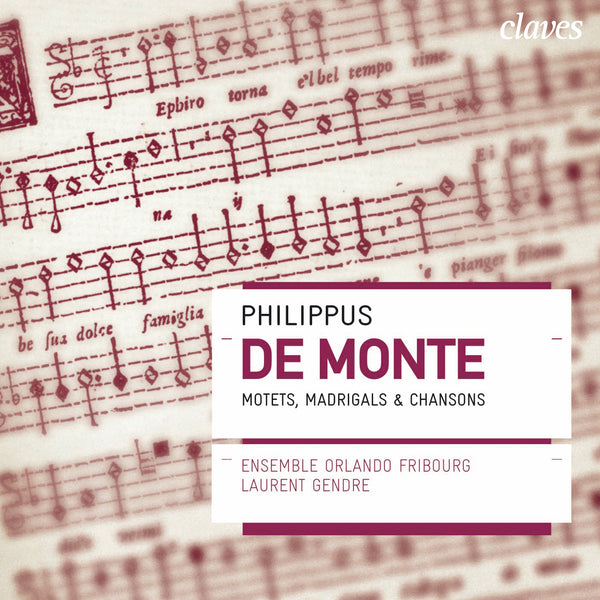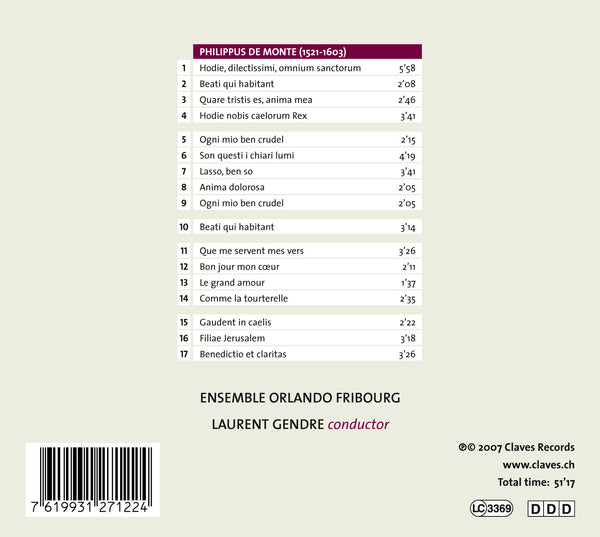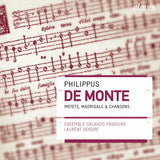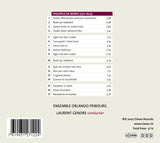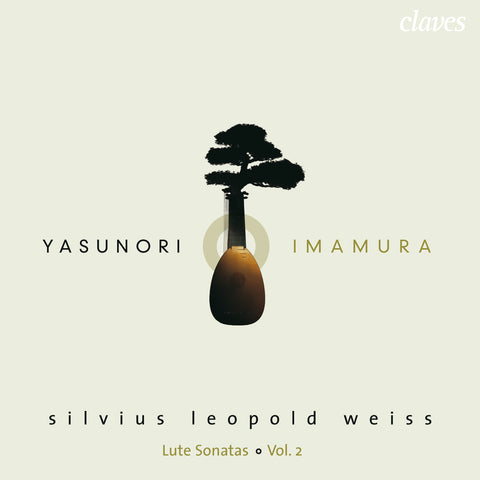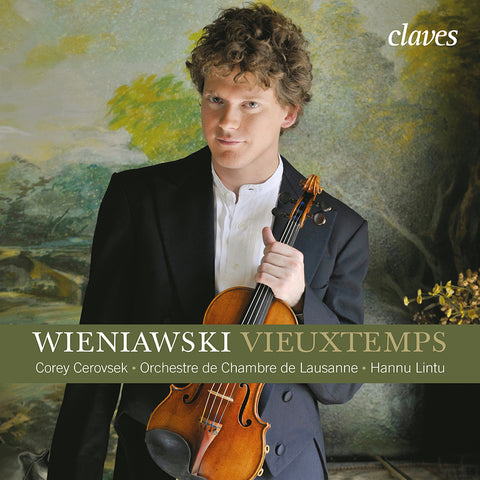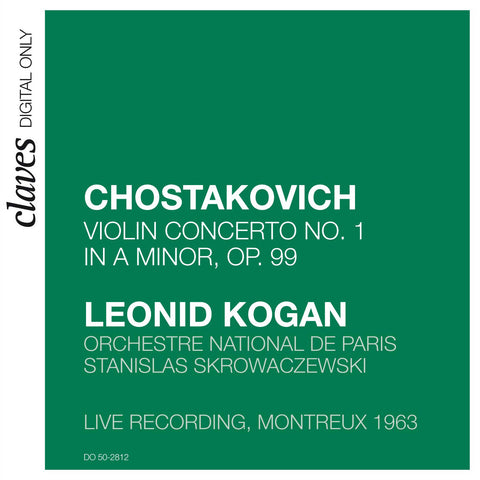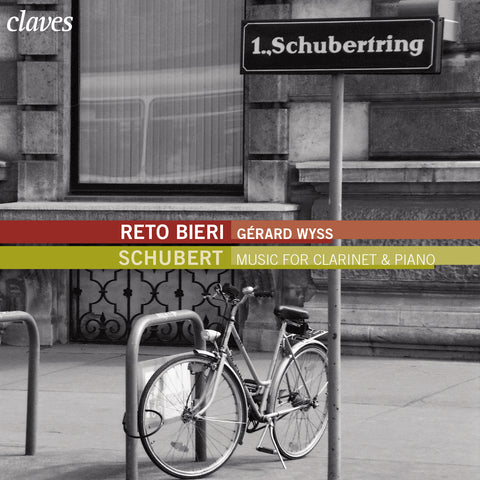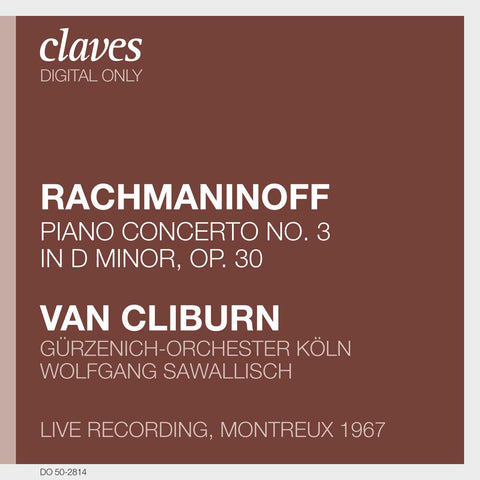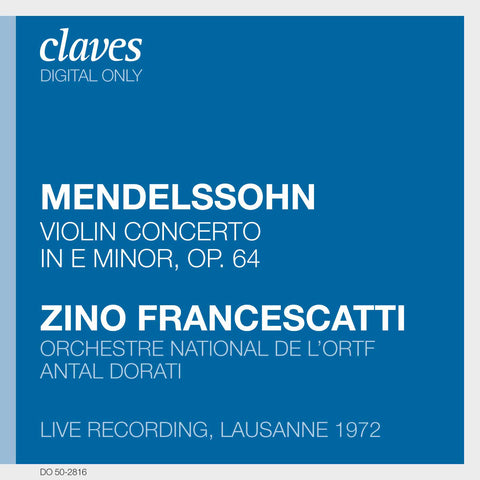(2007) Philippus de Monte; Motets, madrigals & chansons
Catégorie(s): Musique ancienne
Compositeur principal: Philippus de Monte
Chef: Laurent Gendre
Nb CD(s): 1
N° de catalogue:
CD 2712
Sortie: 2007
EAN/UPC: 7619931271224
- UPC: 829410801379
Cet album est en repressage. Précommandez-le dès maintenant à un prix spécial.
CHF 18.50
Cet album n'est plus disponible en CD.
Cet album n'est pas encore sorti. Précommandez-le dès maintenant.
CHF 18.50
Cet album n'est plus disponible en CD.
CHF 18.50
TVA incluse pour la Suisse et l'UE
Frais de port offerts
Cet album n'est plus disponible en CD.
TVA incluse pour la Suisse et l'UE
Frais de port offerts
Cet album est en repressage. Précommandez-le dès maintenant à un prix spécial.
CHF 18.50
Cet album n'est plus disponible en CD.
This album has not been released yet.
Pre-order it at a special price now.
CHF 18.50
Cet album n'est plus disponible en CD.
CHF 18.50
Cet album n'est plus disponible en CD.
PHILIPPUS DE MONTE; MOTETS, MADRIGALS & CHANSONS
Born in Malines (Mechelen) in 1521; where he received most of his musical formation; he was at first active primarily in Italy; Naples being his preferred point of rest. On the peninsula he made contact with different noble families; serving as their musician. In 1554 to 1555 he made a brief excursion to the court of Philip II in Spain; traveling with him to England on the occasion of his marriage to Mary Tudor. He then settled in Anvers where young Roland de Lassus also resided (1532–1594). The two musicians remained in regular contact; above all during the time when Lassus was Kapellmeister to the court of Duke Albrecht V in Munich; who maintained good relations with the imperial court.
Attention to the text
Lassus and de Monte can be considered the two central figures in the last period of the golden age of Franco-Flemish polyphony; which developed at the beginning of the 15th century and determined the stylistic norms in Western Europe for nearly two centuries. The essence of the art of polyphony can be described as the equal treatment of all voices primarily through the technique of imitation. This procedure involves one voice imitating another by employing the same melodic motive or theme.
The works of these two composers were also remarkable for their wonderful euphony; a harmony of sonorities “unheard of” until that time. During the second half of the 16th century (the period of Lassus and de Monte) a third factor grew in significance: the importance of the sung text – a result of the influence of humanism; which placed great weight on the rhetorical power of language. Vocal polyphony would no longer be considered merely as a virtuosic compositional technique but much more as a vast expressive domain in which the text played an increasingly important role.
Sacred music
Philippe de Monte’s sacred music consists of masses and motets dating primarily from the period when he was Kapellmeister at the imperial court. Functional liturgical music in a strict sense; the majority of masses have been preserved in their manuscripts. The motets; numbering some 250; are known due to some dozen publications printed between 1572 and 1600; their style is typically Renaissance.
The compositional techniques are based on a contrapuntal style developed by de Monte’s predecessors but with an emphasis; as we have seen; on a careful setting of the text. While de Monte avoids the contrasts typical of Roland de Lassus and the extreme madrigalist form of expression typical of Giaches de Wert (the Flamish Kapellmeister of the Gonzaga family in Mantua); he succeeds in creating breathtaking settings that convey the atmosphere of the Biblical or liturgical texts.
French chanson
De Monte also made a modest but particularly valuable contribution to the genre of the French chanson; which was popular above all in France and the Netherlands. In 1577 a collection of chansons on texts by Pierre de Ronsard; the poet of preference for many composers; appeared simultaneously in Louvain and in Paris.
De Monte succeeded in setting Ronsard’s charming (occasionally melancholy) poetry in gems such as Comme la tourterelle; Que me servent mes vers or the unforgettable Bonjour mon cœur; which subtly plays on repetitions (of the word “bonjour”; for example) and rhythmic finesses (the alternation between binary and ternary meters). The chanson Le grand amour demonstrates; for its part; that these works could also be performed by purely instrumental ensembles; thereby opening the way for the development of the instrumental canzona in Italy; which later would evolve into the sonata.
De Monte was not a composer of spectacular effects or experimental excesses. The subtle play of the ensemble of polyphonic voices combined with a mastery of expression in which “classic” balance prevails were the means with which he created his delicate gems – works that reveal themselves to those who are ready to listen. Known during his lifetime for his serious and reserved character; in retrospect he reveals himself to be a companion of unsuspected depth and complexity.
Ignace Bossuyt
(Translation: Mark Manion)
Philippe de Monte was 47 years old in 1568 when he succeeded his Flemish compatriot Jacobus Vaet as Kapellmeister at the court in Vienna. At this age most composers were already at the “end of their career”; if not already deceased. No one at the time could have imagined that he would remain in this position for 35 years; first under Maximilian II; then under Rudolf II as of 1576; who then moved the court to Prague in 1580. De Monte did not pass away until 1603 at the respectable age of 82.
Born in Malines (Mechelen) in 1521; where he received most of his musical formation; he was at first active primarily in Italy; Naples being his preferred point of rest. On the peninsula he made contact with different noble families; serving as their musician. In 1554 to 1555 he made a brief excursion to the court of Philip II in Spain; traveling with him to England on the occasion of his marriage to Mary Tudor. He then settled in Anvers where young Roland de Lassus also resided (1532–1594). The two musicians remained in regular contact; above all during the time when Lassus was Kapellmeister to the court of Duke Albrecht V in Munich; who maintained good relations with the imperial court.
Attention to the text
Lassus and de Monte can be considered the two central figures in the last period of the golden age of Franco-Flemish polyphony; which developed at the beginning of the 15th century and determined the stylistic norms in Western Europe for nearly two centuries. The essence of the art of polyphony can be described as the equal treatment of all voices primarily through the technique of imitation. This procedure involves one voice imitating another by employing the same melodic motive or theme.
The works of these two composers were also remarkable for their wonderful euphony; a harmony of sonorities “unheard of” until that time. During the second half of the 16th century (the period of Lassus and de Monte) a third factor grew in significance: the importance of the sung text – a result of the influence of humanism; which placed great weight on the rhetorical power of language. Vocal polyphony would no longer be considered merely as a virtuosic compositional technique but much more as a vast expressive domain in which the text played an increasingly important role.
Sacred music
Philippe de Monte’s sacred music consists of masses and motets dating primarily from the period when he was Kapellmeister at the imperial court. Functional liturgical music in a strict sense; the majority of masses have been preserved in their manuscripts. The motets; numbering some 250; are known due to some dozen publications printed between 1572 and 1600; their style is typically Renaissance.
The compositional techniques are based on a contrapuntal style developed by de Monte’s predecessors but with an emphasis; as we have seen; on a careful setting of the text. While de Monte avoids the contrasts typical of Roland de Lassus and the extreme madrigalist form of expression typical of Giaches de Wert (the Flamish Kapellmeister of the Gonzaga family in Mantua); he succeeds in creating breathtaking settings that convey the atmosphere of the Biblical or liturgical texts.
French chanson
De Monte also made a modest but particularly valuable contribution to the genre of the French chanson; which was popular above all in France and the Netherlands. In 1577 a collection of chansons on texts by Pierre de Ronsard; the poet of preference for many composers; appeared simultaneously in Louvain and in Paris.
De Monte succeeded in setting Ronsard’s charming (occasionally melancholy) poetry in gems such as Comme la tourterelle; Que me servent mes vers or the unforgettable Bonjour mon cœur; which subtly plays on repetitions (of the word “bonjour”; for example) and rhythmic finesses (the alternation between binary and ternary meters). The chanson Le grand amour demonstrates; for its part; that these works could also be performed by purely instrumental ensembles; thereby opening the way for the development of the instrumental canzona in Italy; which later would evolve into the sonata.
De Monte was not a composer of spectacular effects or experimental excesses. The subtle play of the ensemble of polyphonic voices combined with a mastery of expression in which “classic” balance prevails were the means with which he created his delicate gems – works that reveal themselves to those who are ready to listen. Known during his lifetime for his serious and reserved character; in retrospect he reveals himself to be a companion of unsuspected depth and complexity.
Ignace Bossuyt
(Translation: Mark Manion)
Return to the album | Composer(s): Philippus de Monte | Main Artist: Ensemble Orlando Fribourg







